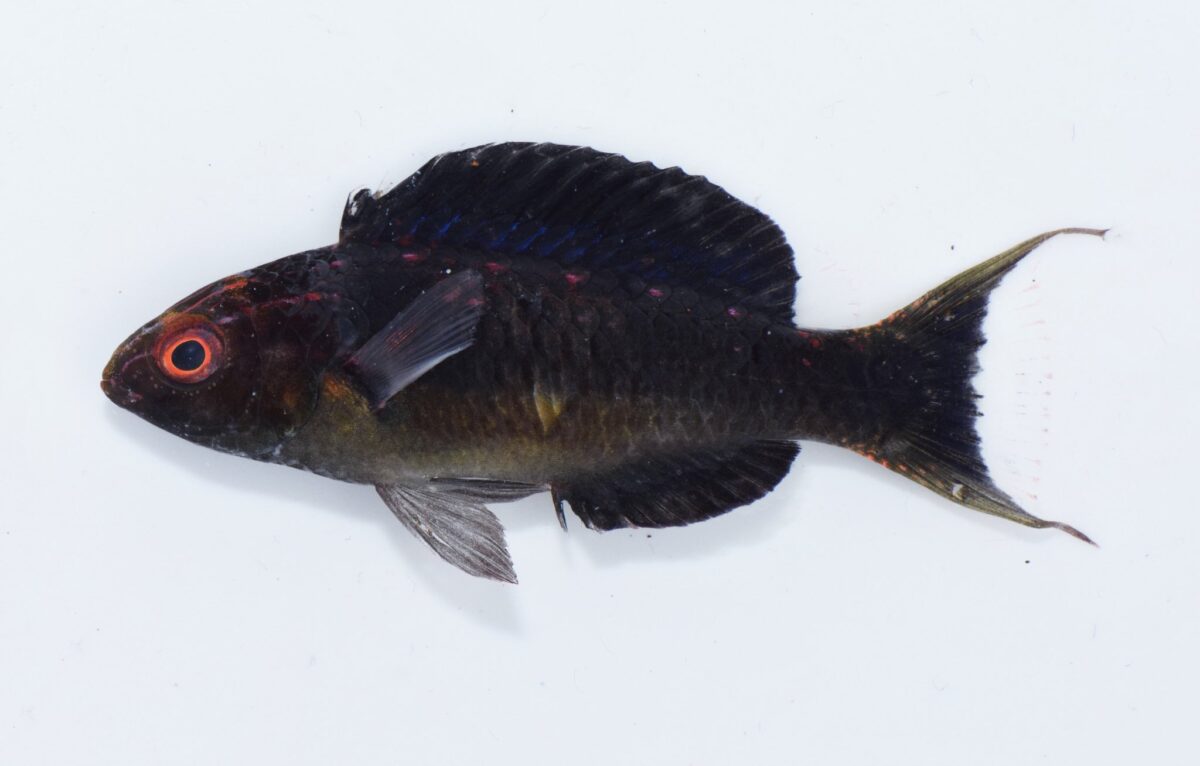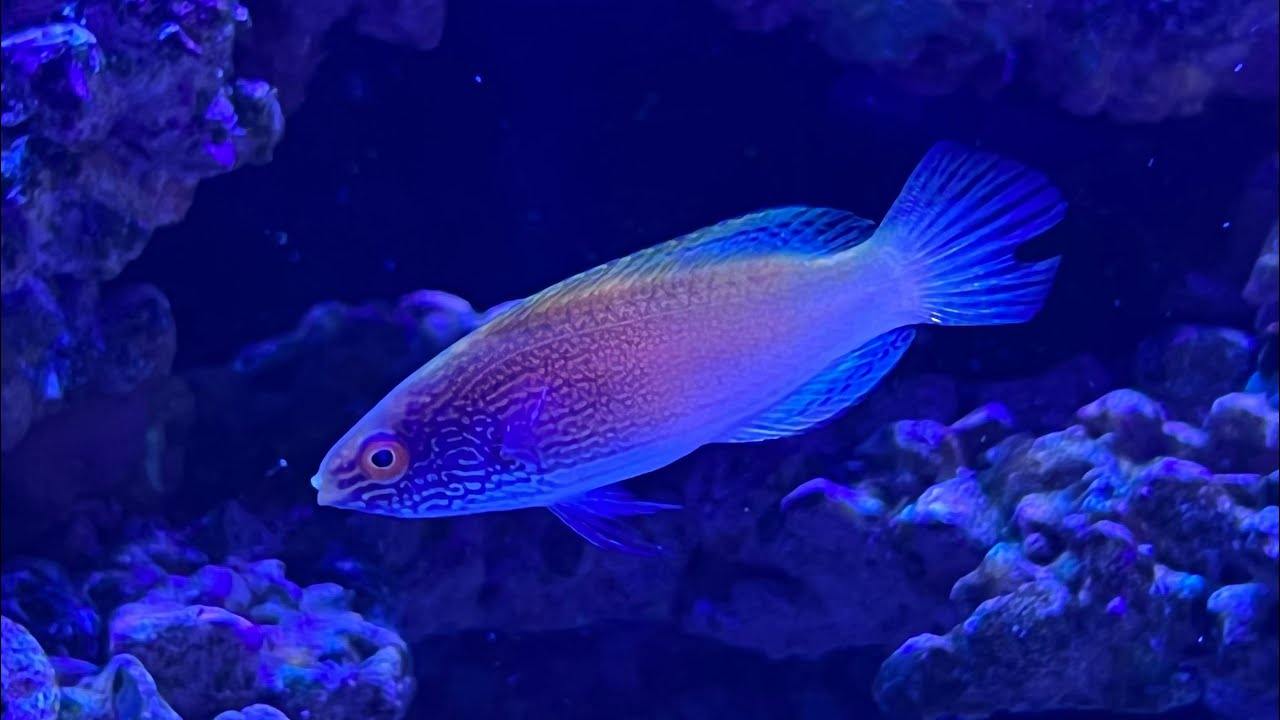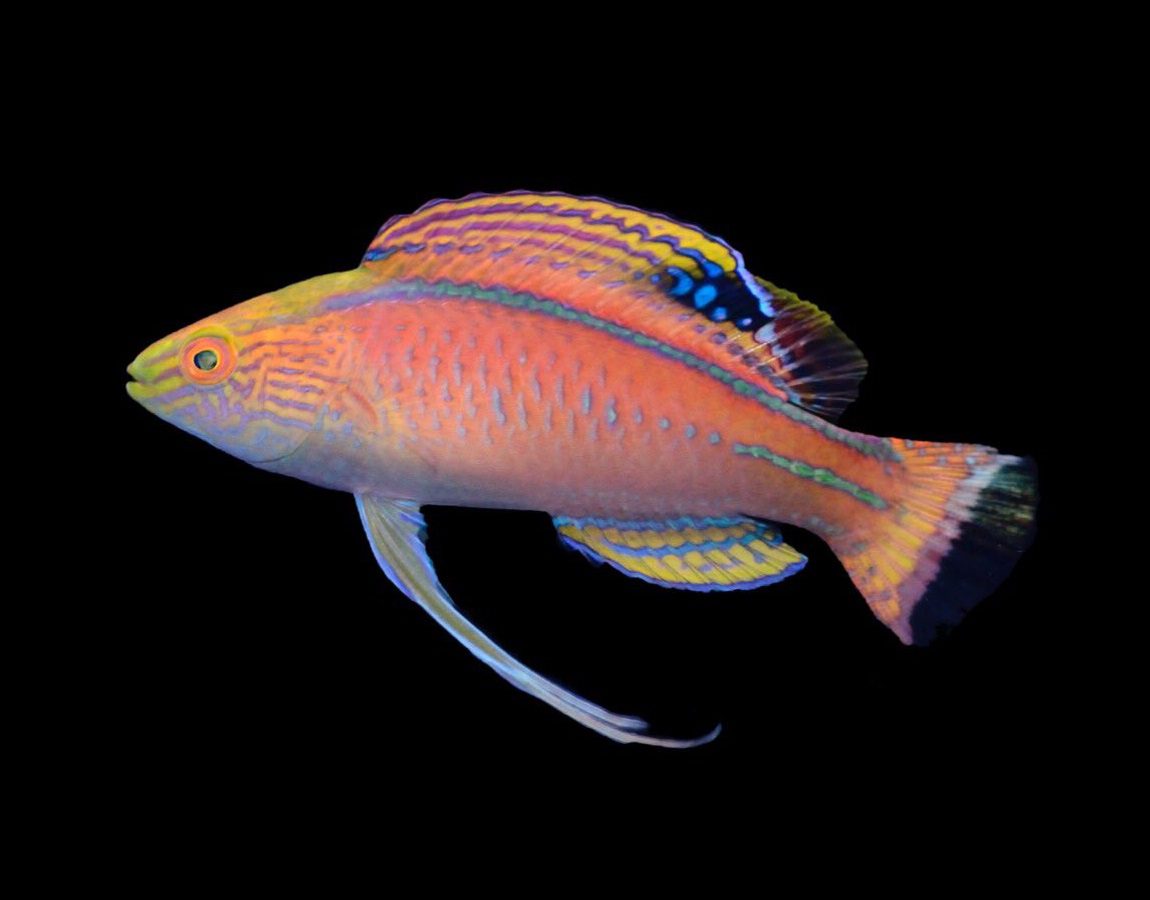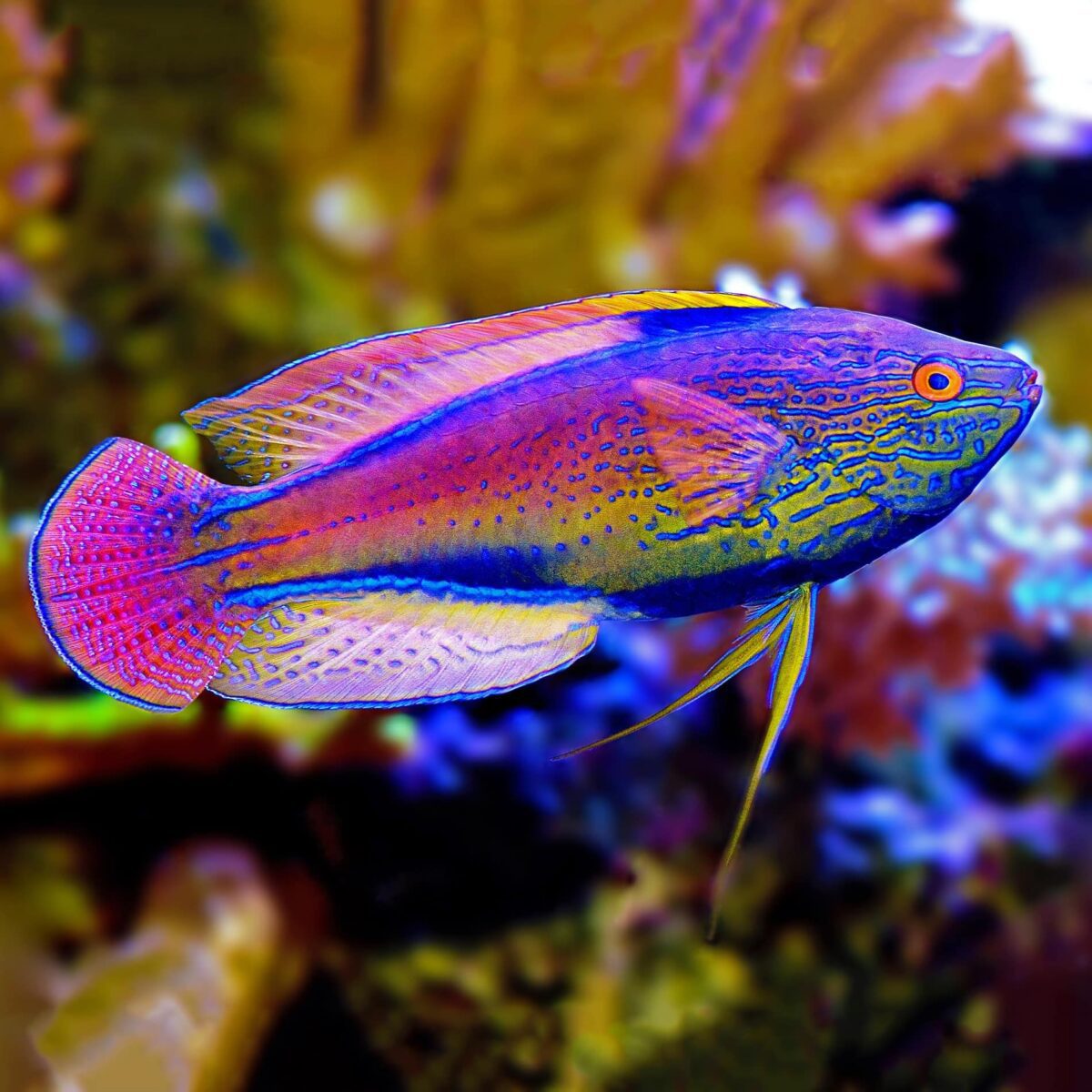Have you ever dreamed of creating an underwater paradise that mesmerizes with its beauty and forms a sanctuary for its inhabitants? Dive into the world of Cirrhilabrus Brunneus, a jewel of the marine aquarium, and discover how it can transform your aquascaping design into a vibrant, living artwork. Isn’t it time to bring the ocean’s magic into your home?
Welcome to our species guide on Cirrhilabrus Brunneus, the Pintail Fairy Wrasse. In this guide, we will explore the fascinating world of this stunning saltwater fish, providing insights into its taxonomy, natural habitat, physical characteristics, care requirements, and more. Whether you’re a seasoned marine aquarium enthusiast or just starting your journey, Cirrhilabrus Brunneus will captivate you with its beauty and charm.
Key Takeaways:
- Cirrhilabrus Brunneus is a captivating saltwater fish that can add vibrancy and beauty to any marine aquarium.
- Understanding the taxonomy, natural habitat, and physical characteristics of Cirrhilabrus Brunneus is essential for providing optimal care.
- Creating the right environment in your aquarium, including suitable tank mates and adequate nutrition, is crucial for the well-being of Cirrhilabrus Brunneus.
- Monitoring water parameters and maintaining a balanced diet are essential factors in maintaining the health of Cirrhilabrus Brunneus.
- By following sustainable fishkeeping practices, enthusiasts can enjoy the beauty of Cirrhilabrus Brunneus while contributing to the conservation of marine species.
Introduction
Welcome to the world of Cirrhilabrus brunneus, a stunning saltwater fish that captivates marine aquarium enthusiasts. In this guide, we will explore the taxonomy and classification of Cirrhilabrus brunneus and its natural habitat and distribution.
Taxonomy and Classification
Cirrhilabrus brunneus belongs to the family Labridae and the genus Cirrhilabrus. This species was first described in 1988 and is part of a rapidly expanding group of fairy wrasses. Its unique characteristics and behaviours make it a fascinating addition to any saltwater aquarium.
Natural Habitat and Distribution
Cirrhilabrus brunneus can be found in the Pacific Ocean, primarily in the northern tip of the Philippines. It also inhabits regions of Japan, Taiwan, and Indonesia. This species thrives in coral reefs and is often spotted in areas with rubble patches and clearings dominated by cyanobacteria and Halimeda algae.
Through careful observation of Cirrhilabrus brunneus, we can gain insight into its fascinating fish behaviour. Understanding this species’ natural habitat and distribution is essential for creating a suitable saltwater aquarium setup and providing proper care for these tropical fish.
Physical Description and Characteristics
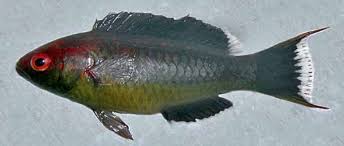
Cirrhilabrus brunneus is a striking aquarium fish known for its vibrant colours and unique markings. The males of this species possess a rich tangerine colouration, with shades of green or purple overlaying the orange base. They feature two prominent stripes along the lateral line, one running along the dorsal and the other along the medial side, extending to the pectoral fin. Additionally, the medial stripe turns upwards along the base of the fin, adding to the fish’s visual appeal. In contrast, females display a more subdued colouration and lack the elongated stripes seen in males.
One of the notable characteristics of Cirrhilabrus brunneus is its peaceful behaviour, making it an excellent choice for community aquariums. When kept with other compatible fish species, it contributes to the overall vibrancy of the tank. Moreover, Cirrhilabrus brunneus is known to be reef-safe, meaning it does not harm coral or other invertebrates, making it a desirable addition to reef aquariums.
Along with its stunning appearance, the behaviour and temperament of Cirrhilabrus brunneus further enhance its appeal. This species generally exhibits calm and non-aggressive behaviour, allowing it to coexist harmoniously with other fish in a community tank. Its peaceful nature and compatibility with various species make it popular among aquarium enthusiasts seeking a vibrant and diverse underwater display.
Aquarium Requirements
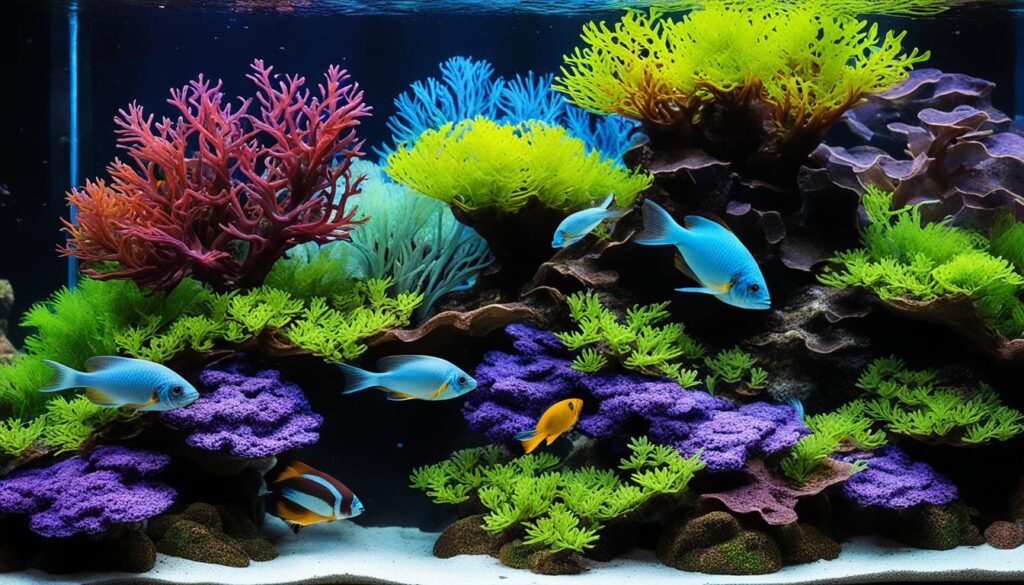
To ensure the well-being of Cirrhilabrus brunneus in captivity, providing the right aquarium conditions is essential. Creating an ideal tank setup for this species involves considering factors such as tank size, water parameters, suitable tank mates, and compatibility with live plants and invertebrates.
Ideal Tank Size and Layout
The ideal tank size for Cirrhilabrus brunneus is a minimum of 30 gallons, although larger tanks are recommended for a more stable environment. A larger tank provides ample swimming space and allows for better water quality management. When designing the layout, it is beneficial to incorporate live rock structures and create hiding places for the fish. These hiding places mimic their natural habitat and provide security for Cirrhilabrus brunneus.
Water Parameters
Maintaining proper water parameters is essential for the health and well-being of Cirrhilabrus brunneus. The recommended temperature range is 75-82°F, with a pH between 8.1 and 8.4. Salinity should be maintained within the range of 1.020-1.025. It is crucial to regularly monitor ammonia, nitrite, and nitrate levels, ensuring they remain at 0 ppm. Keeping the water parameters stable creates a conducive environment that promotes the overall health of the fish.
Suitable Tank Mates and Potential Conflicts
When selecting tank mates for Cirrhilabrus brunneus, it is essential to consider their peaceful nature and compatibility. This species generally gets along well with other reef-safe fish with similar temperament. Avoid aggressive or territorial species that may pose a threat or cause conflicts. Researching the compatibility of different species beforehand can help create a harmonious and stress-free environment for Cirrhilabrus brunneus and its tank mates.
Compatibility with Live Plants and Invertebrates
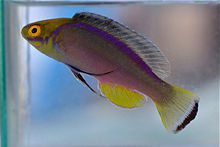
Cirrhilabrus brunneus is generally compatible with live plants and certain invertebrates. However, choosing plants and invertebrates that can coexist harmoniously with the fish is essential. Certain coral species, anemones, and other invertebrates are known to thrive alongside Cirrhilabrus brunneus. Careful consideration should be given to ensure the compatibility of the selected live plants and invertebrates with this species, providing a natural and visually appealing environment in the aquarium.
Implementing these aquarium requirements for Cirrhilabrus brunneus creates an optimal environment for the fish’s well-being. By providing the right tank size, maintaining appropriate water parameters, choosing suitable tank mates, and incorporating compatible live plants and invertebrates, enthusiasts can create a beautiful and eco-friendly aquascape that enhances the overall aesthetic appeal of their saltwater aquarium.
Care
Ensuring the proper care and well-being of Cirrhilabrus brunneus is crucial for its health and longevity. This species is generally hardy and can adapt well to captive environments. Regular water quality testing, maintenance of appropriate water parameters, and a balanced diet are essential for maintaining the health of Cirrhilabrus brunneus.
Diseases
Like any other fish species, Cirrhilabrus brunneus is susceptible to certain diseases, such as bacterial and fungal infections, ich, and parasites. It is essential to monitor their behaviour and appearance closely and take necessary measures to address any signs of illness promptly.
Proper fish health and wellness are crucial for the overall well-being of Cirrhilabrus brunneus. Regular water quality testing helps ensure the aquarium environment is clean and free from harmful contaminants. Monitoring the water temperature, pH levels, and salinity is fundamental in maintaining appropriate water parameters for the fish. This helps to create a stable and stress-free environment for Cirrhilabrus brunneus.
In addition to water quality, a balanced diet is essential for the health of Cirrhilabrus brunneus. This includes feeding them various high-quality foods that meet their nutritional needs. It is essential to offer a mix of frozen and live foods, such as brine shrimp and mysis shrimp, to provide essential vitamins and proteins. Ensuring a diverse diet helps to support their immune system and overall well-being.
Fishkeepers, especially beginners, should know about common diseases affecting saltwater fish. Bacterial and fungal infections can occur due to poor water quality or injuries. Ich, also known as white spot disease, is a common parasitic infection that causes small white spots to appear on the fish’s body.
Parasites, such as marine ichthyophthirius, can also infect Cirrhilabrus brunneus and cause stress and illness. Regular observation and early detection of any signs of disease are crucial for prompt treatment, which can involve using appropriate medications or seeking professional advice.
Sustainable fishkeeping practices can also contribute to the well-being of Cirrhilabrus brunneus. Maintaining stable water parameters, providing natural and suitable habitat, and avoiding harmful chemicals or practices help ensure the fish’s long-term health and sustainability and their environment.
Diet and Feeding
Cirrhilabrus brunneus, being an omnivorous species, has a preference for meaty foods. In the wild, their diet consists of small crustaceans, plankton, and other invertebrates. To ensure their optimal health in captivity, providing a varied diet that includes high-quality frozen and live foods is essential.
Dietary Preferences
Cirrhilabrus brunneus thrives on a diet rich in meaty foods. Incorporating brine shrimp, mysis shrimp, and enriched marine pellets or flakes into their diet will help meet their nutritional needs. These foods mimic their natural prey and provide essential nutrients for their growth and vitality.
Recommended Foods and Feeding Schedule
Feeding Cirrhilabrus brunneus should be carried out at least twice a day. Portions should be appropriate for the fish’s size and activity level. Offering a variety of high-quality frozen and live foods ensures the fish receives a well-rounded and balanced diet. Foods such as brine shrimp, mysis shrimp, and enriched marine pellets or flakes are highly recommended.
Tips on Ensuring a Balanced and Nutritious Diet
When it comes to providing a balanced and nutritious diet for Cirrhilabrus brunneus, a few tips can be helpful. Rotating different types of food is essential to ensure a diverse nutrient intake. Additionally, offering live foods can help stimulate the fish’s natural hunting behaviour. Lastly, it is crucial to maintain good water quality and provide adequate lighting conditions that simulate their natural environment, as this can contribute to their overall health and well-being.
Breeding and Reproduction
Breeding Cirrhilabrus brunneus in captivity can be challenging, as this species exhibits complex reproductive behaviour. Observing the differences in colouration and morphological features between males and females can help determine the sex of Cirrhilabrus brunneus. They engage in courtship displays and spawn in pairs in their natural habitat.
To successfully breed Cirrhilabrus brunneus in captivity, it is necessary to recreate the appropriate conditions that stimulate their breeding behaviour. This includes providing suitable tank parameters, appropriate tank décor, and the presence of compatible mates. Advanced aquascaping techniques can be employed to create an environment that encourages breeding.
Once breeding occurs, removing the eggs and fry from the main tank is crucial to protect them from potential predation. Careful attention must be given to providing the necessary conditions and diet to ensure the survival and healthy development of the fry.
However, breeding Cirrhilabrus brunneus in captivity can be challenging due to their specific breeding requirements. It requires knowledge and experience in advanced aquascaping techniques. Patience, attention to detail, and dedication are essential to breed this species.
Others in the Family: Cirrhilabrus
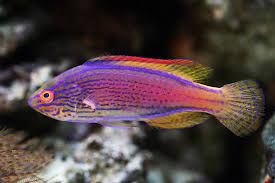 | Add colour and playfulness to your saltwater fish tank with Cirrhilabrus Lineatus, the perfect addition to any aquascaping design! |
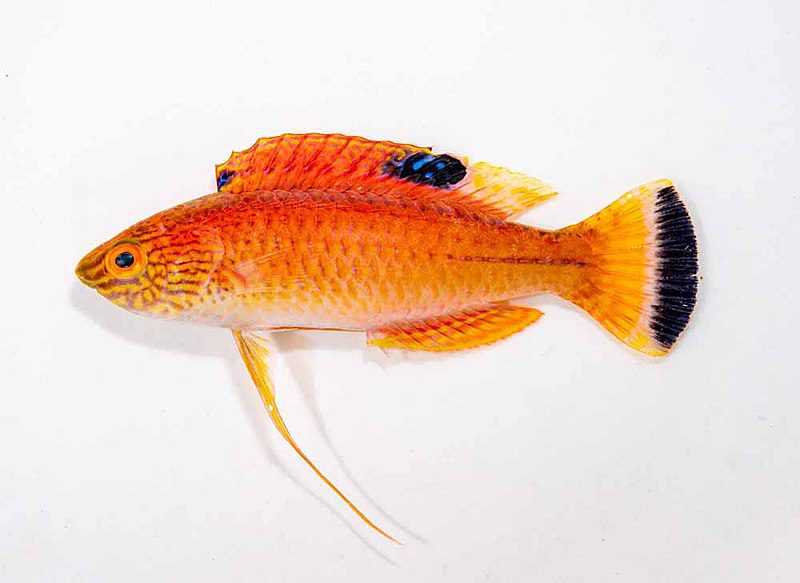 | Experience the vibrant colours and playful behaviour of Cirrhilabrus briangreenei in your saltwater fish tank today! Add some excitement to your aquarium with this unique and beautiful species. |
 | Experience the vibrant colours and playful behaviour of Cirrhilabrus rhomboidalis in your saltwater fish tank today! Add some excitement to your aquarium with this unique and beautiful species. |
Summary
In summary, Cirrhilabrus brunneus, also known as the Pintail Fairy Wrasse, is a captivating saltwater fish that can add vibrancy and beauty to a marine aquarium. This species belongs to the Labridae family and can be found in the Pacific Ocean, primarily in the northern Philippines, Japan, Taiwan, and certain regions of Indonesia. Cirrhilabrus brunneus displays vibrant colours and distinct markings, with males exhibiting rich tangerine hues and strong stripes along the lateral line. Females are less colourful but still possess their unique beauty.
Proper care and attention to the specific needs of Cirrhilabrus brunneus are vital for its health and well-being. This species is generally peaceful and can coexist with compatible fish species in a community tank. It is considered reef-safe and does not harm coral or other invertebrates. Providing suitable tank conditions, maintaining proper water parameters, and offering a balanced diet are essential for the optimal health of Cirrhilabrus brunneus.
By understanding its natural habitat, behaviours, and reproductive requirements, enthusiasts can enhance their experience of keeping Cirrhilabrus brunneus in a marine aquarium. Following sustainable fishkeeping practices benefits the health and longevity of this species and contributes to the conservation of these stunning marine creatures. With the proper care and attention, Cirrhilabrus brunneus can thrive in captivity, delighting enthusiasts with its captivating beauty.
FAQ
What is Cirrhilabrus brunneus?
Where is Cirrhilabrus brunneus found in the wild?
What are the colors and markings of Cirrhilabrus brunneus?
Is Cirrhilabrus brunneus suitable for community tanks?
What are the ideal aquarium requirements for Cirrhilabrus brunneus?
What should I feed Cirrhilabrus brunneus?
Is breeding Cirrhilabrus brunneus in captivity difficult?
How can I ensure the health and well-being of Cirrhilabrus brunneus?
Source Links
- https://reefbuilders.com/2015/05/13/fairy-wrasses-lunatus-group-2/
- https://www.academia.edu/74845962/Cirrhilabrus_isosceles_a_new_species_of_wrasse_Teleostei_Labridae_from_the_Ryukyu_Archipelago_and_the_Philippines_with_notes_on_the_C_lunatus_complex
- https://lkcnhm.nus.edu.sg/wp-content/uploads/sites/10/app/uploads/2017/04/48rbz031-053.pdf

